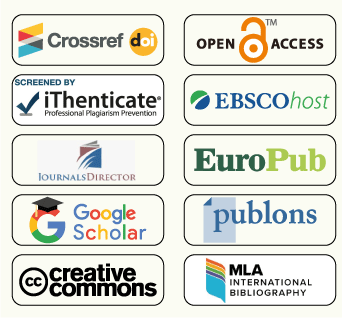The effectiveness of communicative language approach in enhancing English speaking skills of EFL adult learners in Egypt
Abstract
This research aims at investigating the effectiveness of using communicative activities in developing the English speaking ability of Egyptian college students. The study adopted the quasi-experimental pretest- posttest control group design. A group of 40 first year college students were selected from a private university in Cairo in the Academic year 2016- 2017 (20 students in the experimental group and 20 students in the control group). Students of the experimental group were taught by means of the proposed program of the current study; while students in the control group received regular instruction. The equipment and materials consisted of a pre-posttest administered to both groups before and after the treatment and an analytic speaking rubric for assessment. Quantitative data collected were statistically analyzed to validate the research hypotheses. Results of data analysis revealed that the experimental group students outperformed their control group counterparts in overall speaking proficiency. There were statistically significant differences between the mean scores of the experimental group on the pre-posttest in favor of the post- test scores.
Keywords
Full Text:
PDFReferences
Ahmed, H.M.A. (2007). The Effectiveness of Compensatory Strategies Training on Developing English Speaking Skill for First Year Secondary School Students. Unpublished master dissertation, Helwan University.
Aljarf, R. (2007). From reticence to fluency: The effect of TBLT on students' speaking ability. Retrieved July18, 2009, From: http://www. tblt. Download/al-jarf-poster 1. Pdf.
Bachman, L. F. (1990). Fundamental considerations in language testing. Oxford University Press.
Baker, L. & Gershon, S. (2012). Skillful Listening and Speaking: Student’s Book 1. Australia: MacMillan.
Brandl, K. (2008). Principles of communicative language teaching and task-based instruction. Communicative language teaching in action: Putting principles to work, 1-38.
Brown, H. D. (1994). Teaching by principles: an interactive approach to language pedagogy.
Burkart, G. S. (1998). Spoken Language: What It Is and How To Teach It.
Burns, A., & Joyce, H. (1997). Focus on Speaking. National Centre for English Language Teaching and Research, Macquarie University, Sydney, New South Wales, Australia 2109.
Canale, M., & Swain, M. (1980). Theoretical bases of communicative approaches to second language teaching and testing. Applied linguistics, 1, 1.
Cotter, C. (2013).Accuracy and fluency. Retrieved from http://www.headsupenglish.com/index.php/esl-articles/esl-four-skills/494-accuracy-and-fluency
El-Khuli, S.Y.M. (2000). The Effectiveness of Using Questioning Strategies to Develop Speaking Skills in Student’s First Year Secondary School. Unpublished master dissertation, Ain Shams University.
Farahat, A.A.H. (1997). Comparing the Effectiveness of Audio-lingual and Communicative Approaches in Developing Fourth Graders Speaking and Attitudes Towards Studying English. Unpublished master dissertation, University of Tanta.
Harmer, J. (1991). The practice of English language teaching. London: Longman.
Hemmens, A. (2011). Accuracy vs. Fluency. Retrieved from https://www.esl-library.com/blog/2011/07/05/accuracy-vs-fluency/
Hussein, H.A. (2001). The Effectiveness of Some Learning Strategies on Developing the Speaking Skills of Student- Teachers of English. Unpublished master dissertation, Ain Shams University.
Hymes, D. (1971). Competence and performance in linguistic theory. Language acquisition: Models and methods, 3-28.
Kachru, B. B. (1995). Standards, codification and sociolinguistic realism: The English language in the Outer Circle. English in the world: Teaching and learning the language and literatures, 11-30.
Kayi, H. (2006). Teaching Speaking: Activities to Promote Speaking in a Second Language. The Internet TESL Journal.
Krashen, S. (1982). Principles and practice in second language acquisition.
Larsen-Freeman, D. (2000). Techniques and principles in language teaching. Oxford University.
Li, D. (1997). " Absolutely Not the Same": The Potential and Problems of Communicative Language Teaching in China.
Littlewood, W. (1981). Communicative language teaching: An introduction. Cambridge University Press.
Lochana, M., & Deb, G. (2006). Task based teaching: Learning English without tears. The Asian EFL Journal Quarterly September 2006 Volume 8, Issue 3, 8(3).
Nunan, D. (1991). Communicative Tasks and the Language Curriculum. Tesol Quarterly (25)2. pp. 279–295.
Nunan, D. (1999). Second Language Teaching & Learning. Heinle & Heinle Publishers, 7625 Empire Dr., Florence, KY 41042-2978.
OBADI, A. A. A. (2003). FLUENCY IN FOREIGN LANGUAGE LEARNING: A PROGRAMME FOR IMPROVING FLUENCY AMONG EFL STUDENTS OF THE DEPARTMENT OF ENGLISH, UNIVERSITY OF ADEN, YEMEN.
Richards, J. C. (2005). Communicative language teaching today. SEAMEO Regional Language Centre.
Richards, J. C., & Rodgers, T. S. (2014). Approaches and methods in language teaching. Cambridge university press.
Torky, S. A. E. (2006). The Effectiveness of a Task-Based Instruction Program in Developing the English Language Speaking Skills of Secondary Stage Students. Online Submission.
Ying, L. (2010). Communicative activities in ELT classrooms in China. Unpublished master dissertation, University of Wisconsin-Platteville.
DOI: http://dx.doi.org/10.21622/ilcc.2022.02.1.049
Refbacks
- There are currently no refbacks.
Copyright (c) 2024 Marwa Mohamed Hassan Hedia

This work is licensed under a Creative Commons Attribution-NonCommercial 4.0 International License.
Insights into Language, Culture and Communication
E-ISSN: 2812-491X
P-ISSN: 2812-4901
Published by:
Academy Publishing Center (APC)
Arab Academy for Science, Technology and Maritime Transport (AASTMT)
Alexandria, Egypt
ilcc@aast.edu

